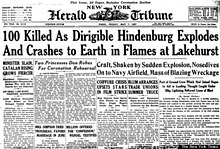New York Herald Tribune

New York Herald Tribune cover on May 7, 1937 covering the Hindenburg disaster
|
|
| Owner(s) |
|
|---|---|
| Founder(s) |
|
| Publisher |
|
| Founded | March 19, 1924 (as New York Herald New York Tribune) |
| Political alignment | Rockefeller Republican |
| Language | English |
| Ceased publication |
|
| Headquarters | New York City |
| Circulation | 412,000 (1962) |
| Sister newspapers | International Herald Tribune |
| ISSN | 1941-0646 |
| OCLC number | 9405828 |
The New York Herald Tribune was created in 1924 when the New York Tribune acquired the New York Herald. It was widely regarded as a "writer's newspaper" and competed with the The New York Times in the daily morning market. The paper won at least nine Pulitzer Prizes during its lifetime.
A "Republican paper, a Protestant paper and a paper more representative of the suburbs than the ethnic mix of the city", the Tribune generally did not match the comprehensiveness of the Times' coverage, but its national, international and business coverage was generally viewed among the best in the industry as was its overall style. At one time or another, the paper was home to such writers as Dorothy Thompson, Red Smith, Roger Kahn, Richard Watts, Jr., Homer Bigart, Walter Kerr, Walter Lippmann, St. Clair McKelway, Judith Crist, Dick Schaap, Tom Wolfe, John Steinbeck, and Jimmy Breslin. Editorially, the newspaper was the voice for eastern Republicans, later referred to as Rockefeller Republicans, and espoused a pro-business, internationalist viewpoint.
The paper, first owned by the Reid family, struggled financially for most of its life and rarely generated enough profit for growth or capital improvements; the Reids subsidized the Herald Tribune through the paper's early years. However, it enjoyed prosperity during World War II and by the end of the conflict had pulled close to the Times in ad revenue. A series of disastrous business decisions, combined with aggressive competition from the Times and poor leadership from the Reid family, left the Herald Tribune far behind its rival.
...
Wikipedia
